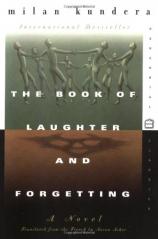Reading Group Guide
Discussion Questions
The Book of Laughter and Forgetting

1. What kinds of laughter does Kundera identify? How is each related to personal and historical memory or forgetting? What makes Kundera's characters laugh? With what consequences? Is it true, as Petrarch insists in Part Five, that "love has nothing in common with laughter"?
2. What importance do you ascribe to the various sexual attitudes and activities of the characters? How are these attitudes and activities shaped or determined by personal objectives, familial background, politics, and/or social mores? To what extent are they expressions of rebellion against family, state, or history?
3. In Part Three, Kundera draws a distinction between "the police in the false unity (imposed, commanded) of the row" and "the young people in the true unity (sincere and natural) of the circle." How do these two "unities"--the row and the circle--appear throughout the novel? Which of the characters are associated with the row, and which with the circle? In what ways does the circle possess a "magical meaning"?
4. At the beginning of Part Four, Kundera writes of Tamina, the heroine of this section and of Part Six, that "I am more attached to her than to any other." Why is this so? What characteristics of Tamina's personality, life, and experiences might account for her creator's attachment to her?
5. In Part Five, Kundera defines litost as "a state of torment created by the sudden sight of one's own misery." What instances of litost do you find in the novel, and in what contexts? To what extent may litost be said to be the defining motif of The Book of Laughter and Forgetting?
6. What is the importance of Kundera's comments, in Part Six, on Beethoven's musical variations? How are Kundera's stories variations on Tamina's story, as presented in Parts Four and Six? How are they variations on the dual theme of laughter and forgetting?
The Book of Laughter and Forgetting
- Publication Date: April 7, 1999
- Paperback: 320 pages
- Publisher: Harper Perennial Modern Classics
- ISBN-10: 0060932147
- ISBN-13: 9780060932145







